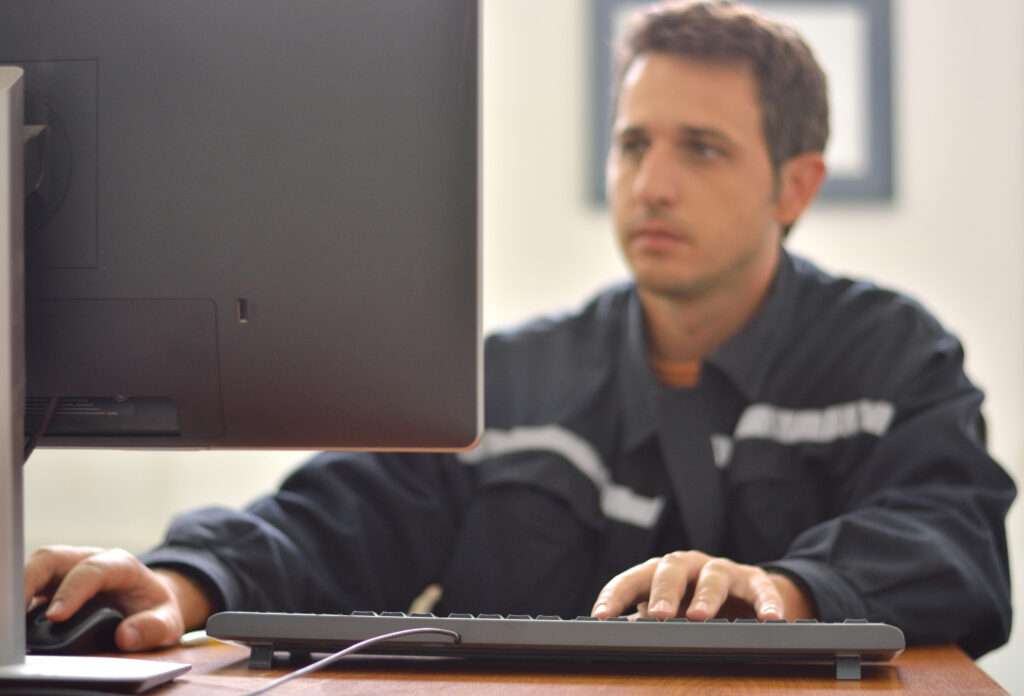[vc_row css_animation=”” row_type=”row” use_row_as_full_screen_section=”no” type=”grid” angled_section=”no” text_align=”left” background_image_as_pattern=”without_pattern” z_index=””][vc_column width=”2/3″][vc_column_text]COVID-19 has brought plenty of attention on workers chained to their desk and their ability to safely work from home, but what about WHS technology for mobile workforces?
When it comes to OHS, HSE and WHS technology and innovations it is imperative that we do not ignore the traditional workers.
These are the workers that are still out there working during the coronavirus global pandemic – often behind the wheel of a vehicle.
They are driving between mining and resources sites in regional areas, more now than ever as flights become restricted and drive-in, drive-out operations begin to replace FIFO.
They are the delivery drivers working tirelessly to manage the tsunami of demand for home-delivered essentials.
They are the tradespeople who are risking their own health and safety by entering residential and commercial properties to carry out their duties and driving between each job.
They are the educators called on to deliver personalised tutoring and care for at-risk students unable to attend traditional schools.
They are the health providers operating outside of centralised clinics and delivering services directly to people’s homes.
These are the workers that most need our support right now, but they are largely being overlooked.
Why Silicon Valley is focusing on those at home, not WHS technology for mobile workforces
It is pretty simple, the major software developers are addressing the issues and challenges that are most clear and present.
They follow trends which means we get apps like Uber Eats when food delivery service demands spike. This also means that apps that reflect the COVID-19 trends are likely to be focused on as well.
When workers are taking their work to home offices en masses, video conferencing apps and other networking tools experience sharp uptakes.
But the thing is, there are 2.7 billion out there who don’t work behind a desk. They make up 80 per cent of the workforce and they are experiencing bigger challenges.
A percentage of them has been lucky enough to work from home, but many, many more have been stood down or have lost their job completely.
And then there are those still working, still driving between job sites, still driving as part of their job function and largely being overlooked when it comes to software and technology innovations.
That is where JMS can assist, with WHS technology for mobile workforces that protects staff when they are travelling between job sites.
What is a journey management system and how does it protect workers?
If one of your workers was travelling between job sites and had an accident, how would you know?
Manual check-in processes mean it could take hours before you knew a worker that was driving was in trouble. These process also mean operating a mobile device while driving, which is highly dangerous and highly illegal.
JMS offers every feature an employer needs to ensure the safety of their travelling workforce.
The easy to use app can be installed on any Apple or Android device with journeys programmed in prior to departure.
The worker then puts the device safely out of reach and their journey is automatically monitored, with predetermined, geofenced checkpoints programmed in along with designated fatigue management stops.
If they do not reach a checkpoint, destination or break point on time, alerts are sent to management via email and mobile alerts.
This happens even in areas where there is limited mobile reception, with JMS using the GPS functionality of the device and sending the last known location if signal is lost and the driver does not reach a checkpoint.
Other features include:
- Fatigue notifications: Letting you know if drivers have been behind the wheel for longer than they are supposed to have been under HSE and WHS guidelines and legislation.
- Full privacy: The app automatically disengages when journeys are complete so drivers will not have their personal movements monitored.
- Verbal reminders: To let drivers know it is time to take a break.
- Duress button: So drivers can be assured help is on the way.
- IVMS integration: If your company vehicles have IVMS installed, we can integrate with those systems. This will override the use of mobile GPS and use that of the vehicle
.The JMS journey management system is your ultimate WHS technology for mobile workforces during the COVID-19 crisis and beyond.
You can trial and demo the JMS system yourself for free as well, just send us your email and we will get you started on your journey towards becoming a safety guardian.
WHS technology for mobile workforces to protect them from exposure to COVID-19
Ionyx is a Brisbane-based software developer and the creator of JMS. Together with Industry Capability Network (ICN) and QMI Solutions, we have developed Site Pandemic Response (SPR) – a survey-based software that allows you to protect your workers from exposure to COVID-19.
Employers can use SPR to easily send a quick symptom/contact/travel survey to contractors and visitors before they enter job sites.
If they have had any exposure to COVID-19, alerts will be sent to management and they can deny entry until the individual has been cleared.
You can also use SPR if you are a mobile worker that needs to access residential properties or commercial premises.
Workers can send the form to the occupants to ensure they are not entering a property where there is a potential risk of being exposed to COVID-19.
This app is another layer of protection for your mobile workforce and it is totally free for small businesses (up to 50 licences) and not-for-profit organisations. Larger companies enjoy significant discounts.
For more information head to the ICN COVID-19 Response website where you can register for free.[/vc_column_text][/vc_column][vc_column width=”1/3″][/vc_column][/vc_row]





